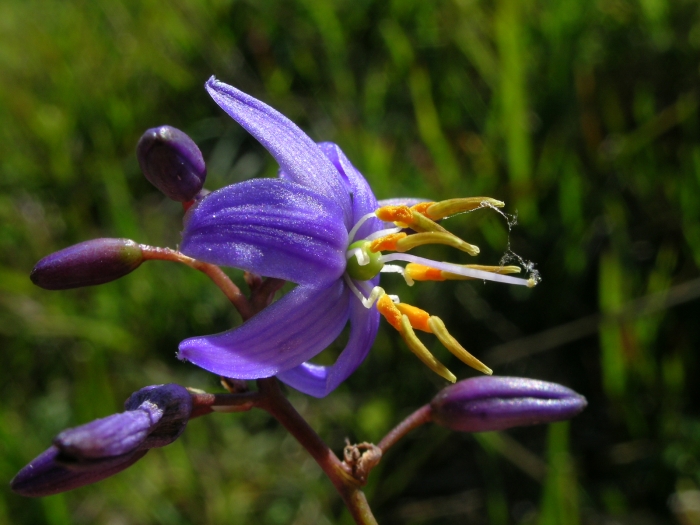Blue Flax-Lily
(Dianella caerulea)
Blue Flax-Lily (Dianella caerulea)
/
/

Macleay Grass Man
CC BY 2.0
Image By:
Macleay Grass Man
Recorded By:
Copyright:
CC BY 2.0
Copyright Notice:
Photo by: Macleay Grass Man | License Type: CC BY 2.0 | License URL: https://creativecommons.org/licenses/by/2.0 | Uploader: Tortie tude | Publisher: Wikimedia Commons | Title: Dianella_caerulea_1.jpg | Notes: {{Information |Description=Melaleuca linariifolia, growing in Sydney, Australia |Source=self-made |Date=2008-01-10 |Author= [[User:Eug|Eug]] |Permission= |other_versions= }} |











































Estimated Native Range
Summary
Dianella caerulea, commonly known as Blue Flax-Lily, is an evergreen perennial herb native to open woodlands and forest margins in Australia. It reaches up to 1 meter in height, with dark green, blade-like leaves up to 70 cm long. The Blue Flax-Lily is notable for its blue flowers in spring and summer, followed by indigo-colored berries. Its strappy, herbaceous growth form features a thick, spreading rhizome. Leaves may have straight or toothed margins, and flowers, 1-1.6 cm in diameter, display a perianth ranging from pale to dark blue or green-blue, with yellowy brown anthers. The spherical berries, 0.7 to 1.2 cm in diameter, are edible.
The Blue Flax-Lily is valued for its hardiness, longevity, and the ornamental appeal of its flowers and berries. It is used in gardens as a low-hedging plant, in rockeries, and in public spaces for its adaptability and attractiveness to wildlife, such as fruit-eating birds and butterflies. It thrives in full sun to part shade, requires low water once established, and tolerates a range of soil conditions, including poor drainage. However, it benefits from extra moisture. While generally disease-free, it can suffer from root rot in overly wet conditions.CC BY-SA 4.0
The Blue Flax-Lily is valued for its hardiness, longevity, and the ornamental appeal of its flowers and berries. It is used in gardens as a low-hedging plant, in rockeries, and in public spaces for its adaptability and attractiveness to wildlife, such as fruit-eating birds and butterflies. It thrives in full sun to part shade, requires low water once established, and tolerates a range of soil conditions, including poor drainage. However, it benefits from extra moisture. While generally disease-free, it can suffer from root rot in overly wet conditions.CC BY-SA 4.0
Plant Description
- Plant Type: Herb
- Height: 1.5-3 feet
- Width: 1.5-3 feet
- Growth Rate: Moderate
- Flower Color: Blue, Purple
- Flowering Season: Spring
- Leaf Retention: Evergreen
Growth Requirements
- Sun: Full Sun, Part Shade
- Water: Medium, High
- Drainage: Slow, Medium
Common Uses
Bee Garden, Bird Garden, Border Plant, Butterfly Garden, Deer Resistant, Drought Tolerant, Edible*Disclaimer: Easyscape's listed plant edibility is for informational use. Always verify the safety and proper identification of any plant before consumption., Erosion Control, Groundcover, Hummingbird Garden, Low Maintenance, Potted Plant, Salt Tolerant, Showy Flowers, Street Planting
Natural Habitat
Open woodlands and forest margins in Australia
Other Names
Common Names: Paroo Lily, Blueberry Lily, Blue Flax Lily, Blaue Flachslilie,
Scientific Names: , Dianella caerulea,
GBIF Accepted Name: Dianella caerulea Sims